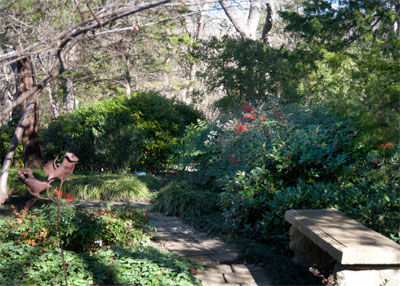From the Sperry Gardens – December, 2011

I was out in our garden for the first time since Christmas. Following a week of drizzle-no-rain, the sun had finally come out. It was still brisk outside, but I really enjoyed the uneventful stroll through the dormant plantings. I was looking for something special to photograph — to share with you in this column, when it dawned on me: we’re going to celebrate the peace and serenity of the mid-winter garden.
This part of our landscape sits to the southeast of our living room. You’ve seen it during the growing season, anchored in shade and flanked by 12 or 15 large pots filled with all manner of tropical plants. (They’re in the greenhouse for the winter.) It’s a fun part of our gardens in spring and summer, but I really enjoy it almost as much during the winter. Here are a few of the reasons.
• The garden takes on a completely different look when the deciduous plants lose their leaves. In this spot, the summer shade comes from the huge pecan trees overhead, as well as the rusty blackhaw viburnum that’s off to the left. Remaining with their evergreen foliage to sparkle in the four months of sun, you see hollies, nandinas, and mondograss and purple wintercreeper euonymus groundcovers.
• You can see the framework of a landscape during the winter. Some professionals refer to it as "the bones" of the garden. Gone are the annuals and even the perennials’ foliage. Gone are the pots and the leaves of the deciduous plants. All you see is what’s permanent, and it lets you determine where changes are needed. (I need some groundcover along the right side of our walk.)
• Some plants step forward visually during the winter. Granted, you only see a few clusters of orange-red nandina berries on down the walk, but they’re definitely there, and the closer you get, the more you appreciate that they’re out there all winter long.
For the record, this is compact nandina. It was brought into the market 50 years ago, and at that time, it was the shorter of the two types. Now we have much shorter selections, but I still dig, divide and replant this great little shrub. This is the third planting made from the original plants that I bought in 1978, and I’ve made three more new beds from this planting in the 12 years it’s been in place.
Oh, yes, the nandina’s winter color is the perfect companion to purple wintercreeper euonymus, the groundcover I have in the distance. You don’t see the similarity of color very well in this photo, but it’s there, and you certainly notice it as you walk ahead 10 or 20 steps. I’d like to think I was a brilliant designer, but I have to admit that I got lucky this time.
